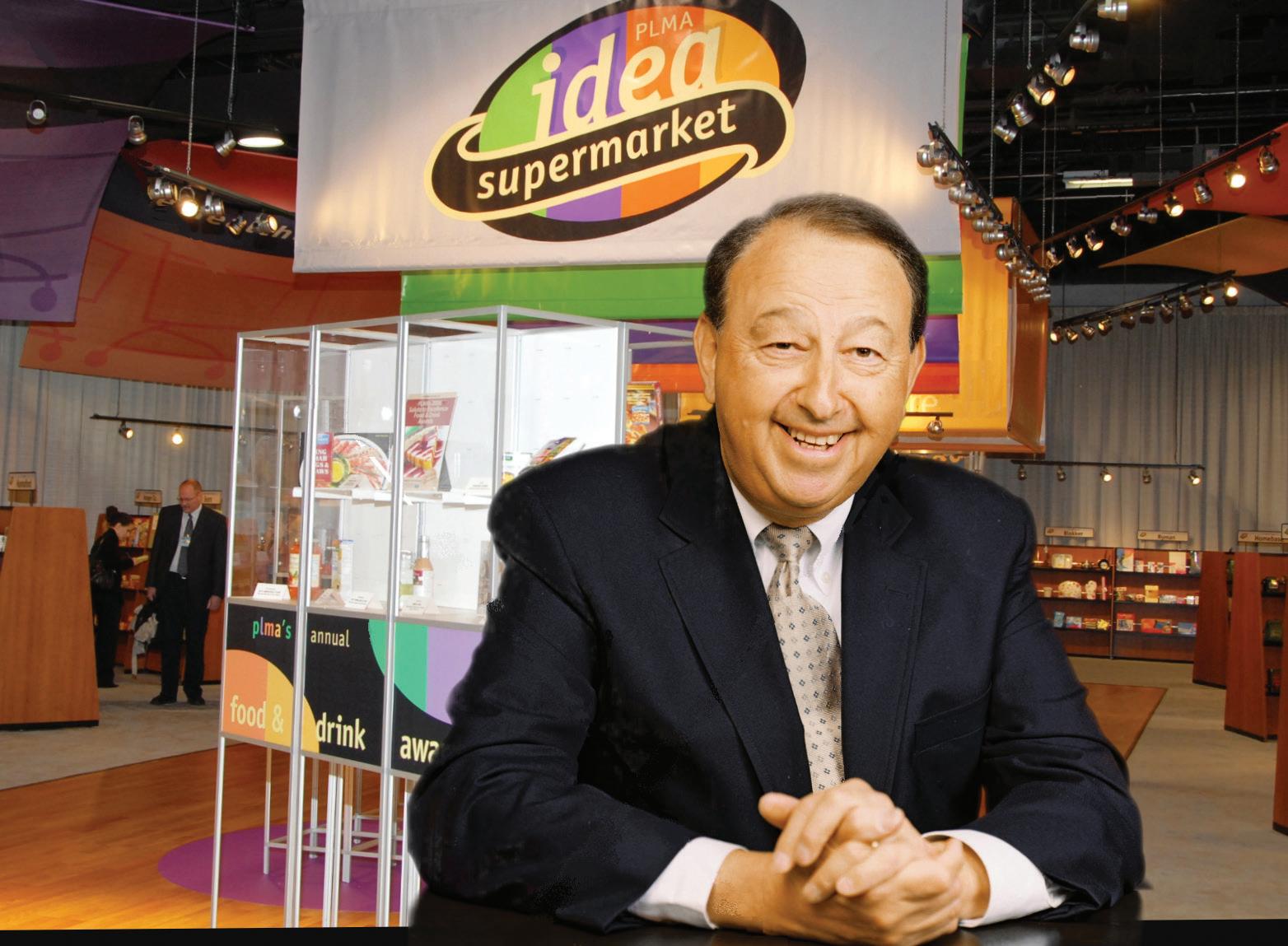
15 minute read
Supply Chain Report
from SB-0321
by ensembleiq
HUNGRY, HUNGRY SHOPPERS
THE RETAIL SUPPLY CHAIN COULD BE FACING A NEW STRESS — A POST-PANDEMIC BOOM OF SHOPPERS LOOKING TO BUY LIKE NORMAL AGAIN
By Dan Ochwat
Consumer demand is pent up and it will be unleashed when this is over,” Nada Sanders, professor of supply chain management at Northeastern University, said during her keynote presentation at last month’s PLMA Live! Presents Private Label Week.
Sanders was addressing a new supply chain dilemma that, by her calculations, retailers and suppliers could be facing as early as this summer. It is a post-pandemic boom of shoppers looking to hit stores and feel closer to normal again. It is a vision of shoppers hungry to explore, discover and shop like it’s 2019 again.
If that were to happen, Sanders said retailers could face another supply chain under duress, and she cautioned merchants to begin monitoring product lead times. She said to create a matrix, sorting by customers, products and suppliers and organize them based on importance and vulnerability. Sanders stressed that retailers and suppliers are in a tough position. The primary goal is to stay financially afloat and make it to the summer recovery, while also maintaining their current market position.
In the meantime, she suggested retailers quickly find alternative sources of supply, as well as gear assortments toward what shoppers are looking for — multipacks, onthe-go products and comfort goods. She also suggested for companies to hire a futurist — a person who can help their organization think differently about the months ahead and how consumers might behave coming out of a pandemic. She said a futurist will be able to identify emotional needs and buying patterns and tap into the factors consumers cannot articulate themselves. The insights could lead to timely product development and help them understand historical shopping data that does not apply to this unprecedented situation.
E-COMMERCE DRIVEN
Jeff Pepperworth, president and CEO of iGPS Logistics, said that one continuing trend to come out of the pandemic will be the rise in online shopping. “Brick-and-mortar will be seen more as a way to get out of the house, and less of a destination for a shopping experience,” he said.
Retailers accelerated how they use online over the last year, a trend Pepperworth does not see changing any time soon. “Retailers now have the ability to get new items online in as few as 24 hours, and this will impact how they determine min/max carrying levels at brick-and-mortar sites,” he said.
Pepperworth cited club stores as an example of realizing huge increases in online spending and curbside pickup. This month, digitally enabled sales at BJ’s Wholesale Club jumped 168% in its quarter ended Jan. 30, whereas physical stores showed comparable-store growth of 13%. Costco reported digital sales increased more than 80% during its second quarter ended Feb. 14 while same-store sales were up 12.6%.
Subodha Kumar, professor of marketing and supply chain management at Temple University, agreed that retailers need to be prepared for online shopping to remain a regular habit. During the peak pandemic, he said a large percentage of customers over the age of 60 went online, and 41% of U.S. consumers bought groceries online for the first time.
If a boom were to occur in the summer months, Pepperworth said the market could see heavy discounting to move product both online and in stores. “Seasonality is now disrupted across many retailers, and with the ports still backed up, there is a lot of merchandise that will be temporarily unavailable but will later flood the market,” he added.
Like many supply chain and logistics companies helping retailers and suppliers manage these supply chain shifts, iGPS maintains constant communication with its clients. “We work directly with our manufacturing customers and have full visibility into their demand needs, which enables us to help them scale in real-time to meet the evolving demands of retail stores and consumers,” Pepperworth said. “Being able to ensure that the right products, in the right quantities, are quickly available online and in brick-and-mortar stores has made us a very vital component of the supply chain.”
Kumar said retailers need to rethink supply chain strategies and push more toward technologies like Blockchain that can improve the speed of information sharing, visibility and security. “We will also see more use of 3-D printing and related technologies, because such technologies can reduce reliance on suppliers in case of any emergencies,” he noted. SB
STATE OF THE INDUSTRY

NUMBERS FROM ANALYSTS AND LEADING RETAILERS SHOW PRIVATE LABEL SOARING IN KEY CATEGORIES

B Y D A N O C H W A T
How are private label sales faring? Most say that the category has done quite well over the course of the COVID-19 pandemic and some add that that momentum should continue well beyond the hopeful end of the crisis.
But, individual categories have different track records over the last year. For example, the frozen foods segment realized its highest sales levels in years thanks to a dramatic decline in in-restaurant dining. Bakery foods, on the other hand, declined on the year, likely due to bakery departments closing during key pandemic months and shoppers not being comfortable buying unpackaged items.
After talking with retailers, studying quarterly reports and getting exclusive insights from Chicago-based market research firm IRI, Store Brands has identified the highest-performing food and nonfood categories to break out during the pandemic.
Perhaps not surprisingly by now, many categories that are driving private label are part of the “stay-at-home lifestyle,” as described by Pam Ofri, director of product development and operations for own brands at Wakefern Food, which saw its biggest category increases in breakfast foods, frozen foods and anything to help shoppers cooking at home.
In nonfoods, what IRI classified as nonedible private brands, annual sales picked up for categories reflecting the home (paper towels, toilet tissue, paper cups and plates) and hygiene, like hair care and the shaving category — possibly driven by consumers concerned with how they looked on Zoom.
Bill Smith, director of Our Brands for Buffalo-based Tops Friendly Markets, said all of the retailer’s private label categories were in the black in 2020. “The household categories clearly saw record increases,” he said. “Other bright spots were baking and pantry style items as well as some great results in perimeter fresh departments. These categories rose to the top due to restaurant restrictions, curfews, consumer anxiety, and remote working/schooling which increased at-home eating habits.”
Tops launched more than 200 new store brand items last year, despite COVID-19, and the unit sales of its Our Brands were “strong double digits over prior year,” he said.
Ofri said Wakefern’s new products augmented the breadth of its Bowl & Basket and Paperbird lines that were introduced at the tail end of 2019. “We have been gradually launching additional categories over time,” she said. “However, our sales and private label unit penetration have increased, so we are performing ahead of schedule.”
The largest chains also reported big 2020 results. Kroger, for example, reported in February that its Our Brands division had its “best year ever,” per comments from chairman and CEO Rodney McMullen delivered during the company’s most recent earnings call. He reported that private label sales at Kroger exceeded $26.2 billion in sales last year. Simple Truth — a cross-category brand — surpassed $3 billion in annual sales.
Albertsons recorded 25% own brand penetration in its most recent quarter, and Target reported in its fourth quarter financials that four of its private brands — Cat & Jack, Up & Up, Threshold and Good & Gather — earned more than $2 billion in sales. The mass retailer has more than 30 own brands, and 10 of them generated more than $1 billion in sales.
From smaller retailers to larger ones, life is good in the private label department. Here’s a closer look at some of the strongest categories.
FROZEN FOODS
According to the “Power of Frozen 2021” report from the American Frozen Food Institute and FMI - The Food Industry Association, frozen food sales grew in dollars (up 21%) and units (up 13.3%) with nearly all types of frozen foods seeing double-digit sales increases.
“Frozen foods are a pandemic powerhouse, ringing in $65.1 billion in retail sales in 2020,” said Alison Bodor, president and CEO of Arlington, Va.-based AFFI.
IRI’s president of strategic analytics Krishnakumar “KK” Davey said within private label foods, frozen foods had the strongest gains, increasing sales by 32% over the prior year. Private label refrigerated foods were up 23%. He said the frozen seafood category, in particular, took off. IRI showed that private label frozen seafood increased in dollar growth year over year by 41%.
Also impressive, private label frozen and refrigerated processed poultry was up 37%, private label frozen soups and sides increased 36%, and private label frozen appetizers grew by 32%.
THE CHEESE BUSINESS
Davey said private label grew in categories that had a strong presence in food stores and natural cheese was right there, along with frozen seafood. In dollar growth, the private label natural cheese category grew 22% in 2020, per IRI.
The Parmigiano Reggiano Consortium, based in Italy, reported that production of Parmigiano-Reggiano cheese hit record highs in 2020, up nearly 5% year over year, adding to a near-8% growth in Italian sales and 10.7% sales growth in other countries. The organization said 3.94 million wheels of cheese were produced in 2020, and the U.S. market saw roughly 2% growth in exports. It makes up 20% of the consortium’s overall exports.
GET COOKING
Other categories that stood out in the IRI report among edible private
PRIVATE BRAND GROWTH VS. NATIONAL BRAND GROWTH
Total Store Growth
Private brands 13%
National brands 12%
Edibles
Private brands 14%
National brands 15%
Nonedibles
Private brands 9% National brands 8%
SOURCE: IRI, YEAR ENDING DEC. 27, MULO, US TOTAL STORE
1] Baby food 2] Ham (refrigerated) 3] Egg substitutes (shelf stable) 4] Salad dressing (refrigerated) 5] Powdered milk 659%
467%
289%
125%
69%
6] Wine 7] Pickles/relish (refrigerated) 54%
49% 8] Asian food 47% 9] Fruit, vegetable preservative/pectin 44% 10] Pizza products 42%
brands listings all had to do with heavy activity in the kitchen: • spices and seasonings saw a 32% year over year increase in dollar growth; • sugar saw a 20% increase in dollar growth; • shelf-stable vegetables grew by 20% in sales; • flour and meal saw sales increase by 31%; • and bread crumbs and batters increased by 30%.
While not the powerhouse categories within food, some smaller private label categories had noteworthy gains in 2020, according to IRI, including frozen baby food, which soared 659% in dollar growth; ham’s 467% year-overyear dollar growth; and shelf-stable egg substitutes, which jumped 289%.
NONFOODS
The high demand in supplyconstrained categories like toilet tissue and household cleaners stood out in nonedible private label growth, Davey said. This is not surprising given the media coverage of shoppers hoarding toilet paper early on in the pandemic. In sales growth, private label toilet tissue grew 24%, per IRI, and private label paper towels grew 26%.
However, some unusual growth in other private label categories cemented what life was like in lockdown, like a need for shaving lotion and men’s fragrances, up 170%; personal thermometers, up 87%; and hair conditioner, up 69%. And to keep the house smelling right, private label candles were up 48%.
Household cleaners also drove private label sales, with sales climbing 44%, while household cloths were up 58% year over year. Other items like bleach saw a jump in sales by 38%, and sponges and scouring pads were up 36%.
According to IRI, consumers spent a greater share of their budget on private brands in 2020, and the category success backs that up. IRI said nearly $1 out of $5 went to store brands, and store brand sales growth modestly outpaced name brands in 2020, up 13% compared with 12% for name brands.
EDIBLE
1] Natural cheese 2] Frozen seafood 3] Milk 4] Meat 5] Fresh eggs 6] Bottled water 7] Spices/seasonings 8] Poultry 9] Breakfast meats 10] Frozen vegetables 1] Toilet tissue 2] Cups and plates 3] Paper towels 4] Vitamins 5] Food and trash bags 6] Pet supplies 7] Cold/allergy/sinus 8] Gastrointestinal tablets 9] Internal analgesics 10] Pet food
SOURCE: IRI, YEAR ENDING DEC. 27, 2020, MULO, US TOTAL STORE
PRIVATE LABEL AS A WHOLE
Looking at the big picture, private label slightly underperformed expectations, according to Krishnakumar “KK” Davey, president of strategic analytics at IRI.
Davey looked back at a study put out in May 2020 from the Chicagobased analysts that predicted private brands would grow by $20 billion in 2020, but his numbers show it grew about $16 billion, an increase of 0.6 share points versus 0.2 a year ago. Nevertheless, it is growth, and Davey said it was driven from a very robust first half of the pandemic, when out of stocks were high. Those early months generated a 0.5 gain and then things stabilized.
“I mean, people just came to stores and grabbed whatever they could, particularly in those critical months of March and April,” he said. “Many categories went out of stock — given that just-in-time inventory that we had all honed over decades.”
Pam Ofri, director of product development and operations for own brands at Wakefern Food, agrees that the supply chain broke down. “As a result, consumers changed their buying patterns to purchase what was on-shelf vs. what brands they were previously loyal to,” she said. “This supported own brand sales as new consumers were incentivized to buy what was in-stock, and it also introduced and converted consumers to our new brands.”
Bill Smith, director of Our Brands, Tops Friendly Markets, saw the same results. “During the beginning of the pandemic, national brands had many supply issues. During that same time, Our Brands had strong in-stock position, increased presence in our weekly ad, and strong instore merchandising,” he said. “The combination of these three gave us
1] Shaving lotion/mens fragrance 2] Personal thermometers 3] Hair conditioner 4] Baby gifts/toys/furniture 5] Household cleaner cloths 6] Home health care/kits 7] Candles 8] Household cleaner 9] Bleach 10] Cosmetics – lip 170%
87%
69%
60%
58%
54%
48%
44%
38%
37%
SOURCE: IRI, YEAR ENDING DEC. 27, 2020, MULO, US TOTAL STORE

the opportunity to showcase Our Brand’s quality and value that drove trial, repeat purchase and loyalty.”
While IRI saw less growth than anticipated for store brands, Davey believes store brands are going to grow — and faster — driven mostly by the leading mass and grocery retailers. He noted that Target, Kroger, Albertsons, Costco, Walmart, Sam’s Club, all were dominant and have changed the culture and appearance of what it means to be a private brand.
Wakefern, H-E-B, Trader Joe’s, and others are among the smaller-footprint retailers changing the culture of private label, but Davey said most of the growth in the industry is coming from those major players, according to their panel data.
“As we stabilize, I think private label will just continue where it left off,” he said. “Large manufacturers are still losing a little bit of share to private label, losing share in the last quarter and quarter or two. And the reason is simple, right? I think private label is becoming smarter. It’s positioning on the premium end of the spectrum, the value end of the spectrum, sustainability, self-care, society care, all of those dimensions.”
IRI also had a recent study show that private label, combined with smaller challenger brands, are moving in on large nationals. In 2020, the consumer goods industry as a whole grew 10.3%, with smaller manufacturers (including companies with annual measured channel sales of less than $1 billion) collectively capturing a third of that growth and private brand products accounted for 18% of that growth. Combined, challenger brands and private brands captured 34.1% of total CPG growth last year. Though large national brands lost market share in each “I think private label is becoming smarter. It’s positioning on the premium end of the spectrum, the value end of the spectrum, sustainability, self-care, society care, all of those dimensions.”
— KK Davey, president of strategic analytics, IRI
of the last five years, they still account for 46.7% of total U.S. sales in measured channels, per IRI.
Davey believes part of this inching into national brands is that private label has captured premiumization. A November IRI study found that consumers were looking to find joy from premium products while at home during the pandemic, and it opened a door for private brands to offer premium items at a lower price. He cited Kroger’s CEO Rodney McMullen:
“In many categories like cheese, beer, and wine and alcohol, shoppers have upgraded in terms of the quality of what they’re buying,” he said. “Customers are splurging because they’re starting to understand the difference in the quality of things. We believe that’s something that will stay forever. Once you have an incredible cheese, you kind of get spoiled and it’s hard to go back to what you had before.”




HONORING ‘MR. PRIVATE LABEL’


THERE IS ONLY ONE INDUCTEE IN THE 2021 PRIVATE LABEL HALL OF FAME — BRIAN SHAROFF — A MAN WHO STANDS ALONE IN HIS ACCOMPLISHMENTS TO MOVE THE PRIVATE LABEL INDUSTRY FORWARD
By Seth Mendelson
Brian Sharoff always managed to stand apart from the crowd.
As the president of the Private Label Manufacturers Association for roughly 40 years, Sharoff was a driving force behind the rise of the private label industry. Serving as a voice for the overall store brands industry as well as someone who called for dramatic changes to the way products were manufactured, packaged and marketed, Sharoff was an advocate for improving the image of the category.
As we all know, Brian passed away after a short illness last May.


